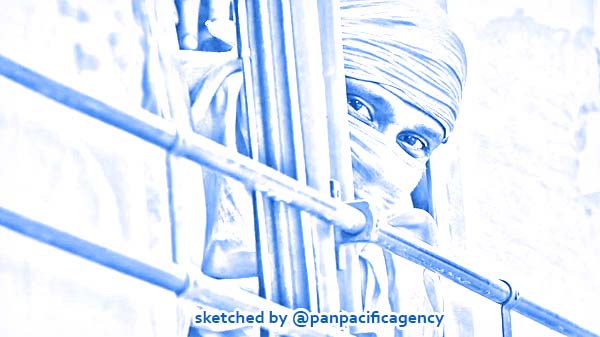India resumes train services, relaxed norms for discharge of Covid-19 patients

A migrant looking through window after boarding a bus in Kolkata on May 10. (Photo: PTI). Sketched by the Pan Pacific Agency.
NEW DELHI, May 11, 2020, India Today. There has been a section of health experts and epidemiologists who advocate herd immunity as the only possible solution to novel coronavirus pandemic. Vaccine, more when than if found, will bring the same prescription to the fore, India Today reported.
Since most patients of Covid-19, the disease caused by novel coronavirus, are either asymptomatic or have mild illness, health economy strategists have been of the view that herd immunity combined with targeted medical care of serious patients is the best way to deal with coronavirus pandemic.
Japan comes closer to the successful example of this counter-Covid-19 strategy. With a comparable population density (336 to 384) with India, Japan too enforced lockdown in its provinces and prefectures but with much more relaxations. It has managed to keep the Covid-19 numbers under 16,000 despite having more intricate socio-economic engagement with China and rest of the world than India.
India has had the most stringent coronavirus lockdown. Still, the cases have just flown northward during all editions of Covid-19 lockdown. On March 24, when nationwide lockdown was announced – most states were already in lockdown – India had less than 600 positive cases of coronavirus infection.
By the end of first phase of lockdown, India was little short of 12,000 coronavirus cases. At the end of second phase of lockdown, India had crossed 40,000-mark for positive coronavirus cases.
In the first week of the third phase of coronavirus lockdown, India recorded nearly 27,000 fresh Covid-19 cases. The numbers increased from about 40,265 on May 3 to 67,185 as on May 10 evening.
This is not to suggest that lockdowns have been ineffective. Without lockdown, India would have been in a worse situation. A study by the International Institute for Population Sciences (IIPS) — a deemed university — India may end with a Covid-19 number of 30 lakh. But without lockdown, the IIPS study said the number be 1.71 crore.
This explains lockdown was a necessary strategy for India. However, this is not a solution as most experts agree. During lockdown, though the number of cases kept staggeringly increasing – with May 10 recording first 4,000-plus fresh Covid-19 cases, the governments at the Centre and in states have considerably increased their capacity to fight the pandemic.
India has set aside around 1.35 lakh hospital beds — ICU plus oxygen support — for Covid-19 patients. Reports suggest less than 1.5 per cent are currently occupied. Rest of Covid-19 patients are in isolation centres. Around 6.5 lakh isolation beds have been earmarked.
Of all Covid-19 patients in India, only 1.1 per cent needed ventilator support and an additional 3.3 per cent oxygen support. Combined less than 5 per cent Covid-19 patients have needed ICU admission.
Lockdowns have set the stage to move on to the next phase of Covid-19 strategy.
This seems to have been prompted the government for subtle change in Covid-19 strategy. The health ministry has now relaxed the norms for the discharge of Covid-19 patients from hospitals if they have mild or moderate symptoms.
Such patients need not be tested for discharge from hospital. Earlier, a coronavirus patient needed to test negative for two consecutive samples taken 24-hour apart to earn a disharge slip. This decision is also linked with shortage of testing kits in the country.
For severe cases – not requiring ICU or oxygen support – the patients could be discharged after one negative test for coronavirus. These patients can now be discharged after 10 days from the onset of Covid-19 symptoms – not from the date of hospitalization – if there has been no fever for three days.
Earlier, no one was to be discharged until doctors were convinced based on test of samples that the patient has recovered from Covid-19.
Discharged patients — under modified norms — are required to follow a 7-day home quarantine/isolation. Earlier, patients were to be in quarantine/isolation for 14 days.
This opens up the risk that some of the Covid-19 patients discharged from hospitals may spread the virus to new persons. Since more and more patients are recovering and being discharged every day from hospitals, this strategy is building the case for herd immunity.
Further, parks are being allowed to open in Delhi. They had been shut since March 25. Delhi parks have been the meeting ground for all kinds of social activities for the residents. This decision comes within days of Delhi Chief Minister Arvind Kejriwal saying people will have to learn to live with coronavirus.
But the biggest of all indications that the government may be preparing the country for herd immunity against novel coronavirus came from the railways. The government has decided to restore train services, though cautiously.
Trains connecting 15 big cities with Delhi are to begin their round-trip from May 12 – five days before the third phase of coronavirus lockdown ends. Cities to be connected include Mumbai, Howrah, Patna, Bengaluru and Ahmedabad – all in states on coronavirus watch.
On Monday, even the guidelines for Shramik Special trains were modified. Now, the train can run to its full berth capacity and also stop at three stations. Earlier, these trains operated on soure-to-destination mode.